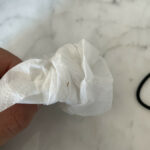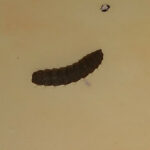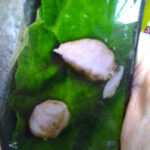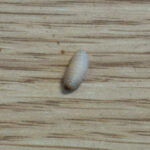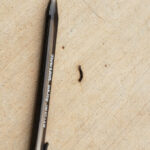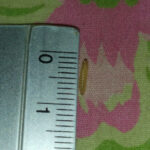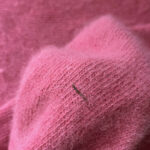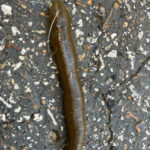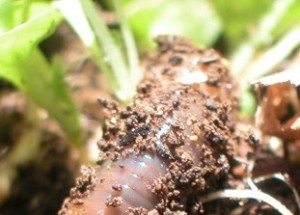We received a question recently about a worm that a reader found in his bathroom. More precisely, the worm was found in the “gunk” between the tub and sliding door. The reader actually said he “found a ‘worm’ in the bathroom,” which we call attention to only because of the reader’s use of scare quotes. The reader acknowledges that he might not have found a worm at all, and in fact he probably didn’t. The “worm” in the bathroom could be a larva (or something else – it’s hard to say, as you’ll see). The reader was wondering what he had found, and also if a mere cleaning could address the problem.
The reader supplied us with a praiseworthy description of the creature he found. He described it in as much detail as one could reasonably expect, including such crucial details as the size of the creature (12 mm, or slightly less than a half an inch, long) and the part of the world in which it was found (Elk Grove, California, which is near Sacramento). The creature is further described as having a segmented body and a round head with antennae.
This is all wonderful and helpful information, but it is hard to assess what this creature might be without a picture. As we have explained before, it is not as if we can immediately identify any given creature when presented with a picture, but photos are an excellent way to confirm our suspicions – it is always helpful to check a reader’s pictures against other pictures. So, this is one reason why we are hesitant to offer any confident guesses as to what our reader might have found.
We are given further pause by the fact that two possibilities we might suggest to our reader were preemptively shot down. Our first hypothesis was that our reader found moth fly larvae, a creature we have written about well over a dozen times. The fact that the reader found the creature immersed in bathroom gunk screams moth fly larva. This is exactly where you would expect to find one, happily feeding on a bounty of decaying organic matter. However, the reader explicitly referenced moth fly larvae, dismissing the possibility on account of the size of the creature he found. The fact that the creature has antennae also complicates this possibility, as moth fly larvae don’t really have any features that one would mistake as antennae, although adult moth flies have fairly prominent antennae, so perhaps the reader saw a moth fly in some late phase of the pupal stage of development (but then the creature wouldn’t look worm-like, and it certainly wouldn’t be 12 mm long). For what it’s worth, while all insects have antennae, they are often severely reduced on larvae (to the point where you can’t see them). So, the fact that our reader specifically called attention to the creature’s antennae makes us wonder if he found any sort of larva at all.
The reader also mentioned that the creature curled up when disturbed, which is a hallmark of millipedes – another creature one might find in a bathroom – but the reader specifically mentioned that when examined under a magnifying glass, the creature didn’t appear to have any legs. Obviously, millipedes have lots of legs (two per body segment, in fact).
What are we to conclude? Frankly, we cannot really conclude anything because we are confronted with too much uncertainty. If we were forced to guess, we would have to say that the reader found moth fly larvae, despite some of the indications to the contrary (maybe our reader didn’t get the physical description quite right?), because these are such common larvae to find in precisely the situation in which our reader found his creatures. But that’s really all we can say.
As to our reader’s question about cleaning, yes, a mere cleaning is the best initial step one can take upon finding some sort of creature in their bathroom. Obviously, something like a moth fly larvae needs a source of food, and if the source of food is removed through cleaning, then they will no longer be able to live in that area. This is a basic rule that can be applied to all sorts of different pests. Cleanliness seems to be the best defense against any sort of infestation (not that our reader is anywhere close to dealing with an infestation).
Unfortunately, we can’t say exactly what our reader found. The two possibilities that came to mind – moth fly larvae and millipedes – were ruled out by the reader himself, although we still have suspicions about the former. Regardless of what our reader found, though, we hope that our generic cleaning advice will help him address the problem.
All About Worms is always free, always reader-supported. Your tips via CashApp, Venmo, or Paypal are appreciated! Receipts will come from ISIPP Publishing.



